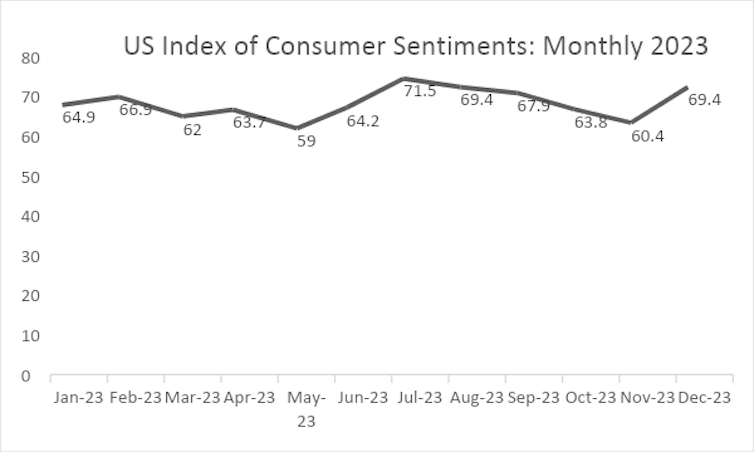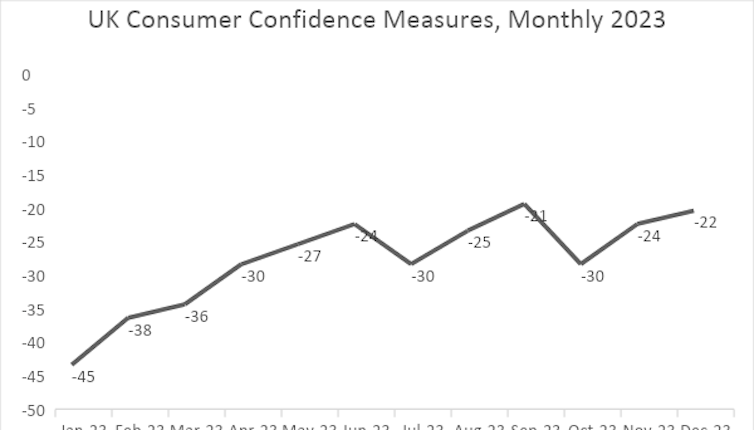People’s confidence in the UK’s economic outlook improved towards the end of 2023, despite continuing to battle a cost-of-living crisis. Although it has strengthened over the year to December, “consumer sentiment” as this confidence is called, is still in negative territory.
Indeed, UK consumer price inflation remains well above the Bank of England’s 2% target and interest rates are at highs not seen since the wake of the global financial crisis in 2008?. And, of course, the outlook for the UK economy in 2024 is also in the doldrums.
British economist John Maynard Keynes talked about “animal spirits” meaning the psychological factors that drive firm’s investment decisions. But economists also take people’s feelings into account when making predictions about the direction of the economy. So, with consumer confidence rising in spite of all of these negative indicators, what role does this kind of optimism play in economic forecasts?
Traditionally, when trying to gauge the country’s financial prospects, economists focused on households’ ability to consume, arguing that expectations of future household income are a crucial determinant of people’s current consumption. For instance, you’ll be more reluctant to splash out now if you think inflation is going to sky-rocket next year, squeezing your finances in the future.
But willingness to consume is also increasingly important to economists, especially during difficult times. Such “consumer sentiments” describe the psychological state of households, or people, rather than the present reality of their personal finances. When economists know people are optimistic about the economy, they assume they are more willing to spend or consume more and, if not, they are expected to save more instead.
In the US, consumer sentiment is tracked by the University of Michigan’s Surveys of Consumers, which is based on a monthly poll of a sample of households. UK consumer sentiment is represented by the GfK Consumer Confidence Barometer, also a monthly survey of households.
Both measures ask people about their personal finances and their thoughts on the general economy. Participants are asked about plans for large purchases, especially durables such as white goods and cars, as well as their views about what has happened in the past year (backward-looking) and their opinion of prospects over the next year (forward-looking). The US index is more focused on households’ forward-looking views, at least with regards to the overall economy.

Economists are interested in people’s future spending plans for large items like washing machines. UfaBizPhoto/Shutterstock
Why are these consumer surveys so important?
People’s willingness to spend money is affected by special or extreme events. The financial crisis of 2007-08, the COVID pandemic and Russia’s invasion of Ukraine all dragged down consumer sentiment.
Recent research also shows that good and bad news has an uneven effect on consumer sentiment. In particular, good news about the general economy will have a greater and more lasting impact than bad news.
In the US, for example, recent good news about jobless rates falling to the lowest point since July, together with the future prospect of lower inflation, has boosted households’ willingness to consume. After falling continually for the preceding four months, US consumer sentiment increased sharply in December.
Consumer confidence in the US economy has risen in recent months. Author provided using data from Survey of Consumers, University of Michigan, CC BY-NC-ND
The US Federal Reserve has indicated that interest rates will be held and perhaps even fall in 2024 as inflationary pressures ease. So, the outlook for an easing of inflationary pressures once recent interest rate rises take full effect seems to have had a positive effect on consumer sentiment.
A gloomier outlook for the UK economy
The picture in the UK is somewhat different. While inflationary pressures have eased recently, the current rate of 3.9% is still well above the Bank of England’s 2% target. Also, unlike the US Federal Reserve, the Bank of England is less likely to cut interest rates anytime soon, while recent data on economic growth has been disappointing. In October, the economy shrank by 0.3% and unemployment rates are currently around 4.3%, with pay growth easing.
Consumer confidence in the UK remains in negative territory but people are feeling more optimistic. Author provided using data from GfK, CC BY-NC-ND
Nevertheless, consumer confidence has increased in the last two months, after a sharp fall in October. That decrease may have been due to the Gaza conflict and fears about its potential impact on the global economy.
So, both UK and US consumers seem to feel fairly optimistic about their personal finances and the wider economy right now. The obvious common factor among the two economies is the easing of inflationary pressures, which many people will be hoping will reduce the pressures of the cost of living crisis. But even though confidence is growing, neither country is out of the woods yet when it comes to the economic outlook.



 U.S. Dollar Steadies Near October Lows as Rate Cut Expectations Keep Markets on Edge
U.S. Dollar Steadies Near October Lows as Rate Cut Expectations Keep Markets on Edge  Canada Signals Delay in US Tariff Deal as Talks Shift to USMCA Review
Canada Signals Delay in US Tariff Deal as Talks Shift to USMCA Review  Oil Prices Steady in Asia but Headed for Weekly Loss on Supply Glut Concerns
Oil Prices Steady in Asia but Headed for Weekly Loss on Supply Glut Concerns  Asian Currencies Slip as Dollar Strengthens; Indian Rupee Rebounds on Intervention Hopes
Asian Currencies Slip as Dollar Strengthens; Indian Rupee Rebounds on Intervention Hopes  U.S. Stock Futures Slip After CPI-Fueled Rally as Markets Weigh Economic Uncertainty
U.S. Stock Futures Slip After CPI-Fueled Rally as Markets Weigh Economic Uncertainty  BOJ Poised for Historic Rate Hike as Japan Signals Shift Toward Monetary Normalization
BOJ Poised for Historic Rate Hike as Japan Signals Shift Toward Monetary Normalization  Asian Currencies Trade Sideways as Dollar Weakens Ahead of Key U.S. Data
Asian Currencies Trade Sideways as Dollar Weakens Ahead of Key U.S. Data  New Zealand Business Confidence Hits 30-Year High as Economic Outlook Improves
New Zealand Business Confidence Hits 30-Year High as Economic Outlook Improves  Yen Near Lows as Markets Await Bank of Japan Rate Decision, Euro Slips After ECB Signals Caution
Yen Near Lows as Markets Await Bank of Japan Rate Decision, Euro Slips After ECB Signals Caution  Asian Stocks Edge Higher as Tech Recovers, U.S. Economic Uncertainty Caps Gains
Asian Stocks Edge Higher as Tech Recovers, U.S. Economic Uncertainty Caps Gains  Dollar Holds Firm Ahead of Global Central Bank Decisions as Yen, Sterling and Euro React
Dollar Holds Firm Ahead of Global Central Bank Decisions as Yen, Sterling and Euro React  BoE Set to Cut Rates as UK Inflation Slows, but Further Easing Likely Limited
BoE Set to Cut Rates as UK Inflation Slows, but Further Easing Likely Limited  South Korea Warns Weak Won Could Push Inflation Higher in 2025
South Korea Warns Weak Won Could Push Inflation Higher in 2025  Asian Stocks Slide as AI Spending Fears and Global Central Bank Decisions Weigh on Markets
Asian Stocks Slide as AI Spending Fears and Global Central Bank Decisions Weigh on Markets  Japan Exports to U.S. Rebound in November as Tariff Impact Eases, Boosting BOJ Rate Hike Expectations
Japan Exports to U.S. Rebound in November as Tariff Impact Eases, Boosting BOJ Rate Hike Expectations  RBA Unlikely to Cut Interest Rates in 2026 as Inflation Pressures Persist, Says Westpac
RBA Unlikely to Cut Interest Rates in 2026 as Inflation Pressures Persist, Says Westpac  Oil Prices Climb on Venezuela Blockade, Russia Sanctions Fears, and Supply Risks
Oil Prices Climb on Venezuela Blockade, Russia Sanctions Fears, and Supply Risks 


































